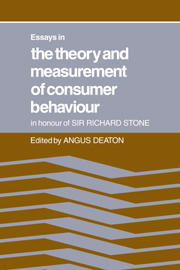Book contents
- Frontmatter
- Contents
- Foreword
- List of contributors
- Part one The analysis of commodity demands
- Introduction
- 1 Some Engel curves
- 2 Suggestions towards freeing systems of demand functions from a strait-jacket
- 3 Theoretical and empirical approaches to consumer demand under rationing
- 4 The independence transformation: a review and some further explorations
- 5 The analysis of consumption and demand in the USSR
- Part two The theory of index numbers
- Part three The consumption function and durable goods
- Part four Other aspects: fertility and labour supply
- Bibliography of Sir Richard Stone's works 1936–79
- Index of names
- Subject index
5 - The analysis of consumption and demand in the USSR
Published online by Cambridge University Press: 05 November 2011
- Frontmatter
- Contents
- Foreword
- List of contributors
- Part one The analysis of commodity demands
- Introduction
- 1 Some Engel curves
- 2 Suggestions towards freeing systems of demand functions from a strait-jacket
- 3 Theoretical and empirical approaches to consumer demand under rationing
- 4 The independence transformation: a review and some further explorations
- 5 The analysis of consumption and demand in the USSR
- Part two The theory of index numbers
- Part three The consumption function and durable goods
- Part four Other aspects: fertility and labour supply
- Bibliography of Sir Richard Stone's works 1936–79
- Index of names
- Subject index
Summary
In the USSR, consumption and demand undergo both constant growth in volume and qualitative structural change. The total growth of consumption and demand may be illustrated by the data on retail sales which by 1978 had increased 2.4-fold over the 1965 level. In addition, consumption and demand patterns constantly undergo considerable qualitative changes due to increases in the consumption of, and demand for, high-calorific food, for non-foods that satisfy developing needs, and for products that make house-keeping easier and save time. Thus the total sale of meat and meat products increased 2.1 times between 1965 and 1977. For the same period the corresponding figure for milk and milk products was 2.1, for eggs 3.7, and for fruit 2.2. At the same time, the consumption of bread and potatoes per capita has decreased and the level of sugar and vegetable oil consumption has been constant, in accordance with physiological standards.
Among non-foods the demand for knitted garments and carpets had the highest rate of growth during this period (i.e. 1965–77) increasing 3.3-fold and 5.7 respectively. Furniture sales increased 2.3-fold, articles for cultural and domestic needs 2.4-fold and so on. The provision of most durable goods has also been improved. Thus the supply of TV sets increased 3.3 times during the period, refrigerators by 6.5 times, washing machines by 3.3 times, vacuum cleaners by 3.1 times and so on.
- Type
- Chapter
- Information
- Essays in the Theory and Measurement of Consumer Behaviour: In Honour of Sir Richard Stone , pp. 113 - 128Publisher: Cambridge University PressPrint publication year: 1981



